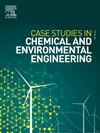用喷射式气泡发生器研究微泡在水中溶解的水动力特性
Q1 Environmental Science
Case Studies in Chemical and Environmental Engineering
Pub Date : 2024-12-04
DOI:10.1016/j.cscee.2024.101043
引用次数: 0
摘要
本研究采用喷射式气泡发生器测定水的流动结构和溶解氧。喷射器的水平位置,从传统的文丘里改进,利用在进水口的横截面逐渐减少,并在混合区域之前包含空气空间。实验测量了气泡尺寸分布和溶解氧,并通过量纲分析得到了包含Martinelli参数影响的经验相关性。研究了在0.1 ~ 1.5 lpm气流范围内,喷嘴直径为1.17 ~ 3.50 mm时的微泡特性和体积传质特性。利用高速摄像机图像处理技术获得气泡大小分布,用极谱溶解氧仪记录溶解氧。基于研究变量,空气/水排出比和喷嘴直径对气泡尺寸的影响较大,气泡尺寸的相关系数分别为0.572和0.598。它们的氧传递速率相关系数分别为- 17.411和5.928。结果表明,空气/水比和喷嘴直径对气泡大小和氧气传递速率有显著影响。本文章由计算机程序翻译,如有差异,请以英文原文为准。
Hydrodynamic characteristics of the microbubble dissolution in water using an ejector-type bubble generator
This research uses an ejector bubble generator to determine water's flow structure and dissolved oxygen. The horizontal position of ejector, modified from conventional venturi, utilizes a gradual reduction in cross-section at the water inlet and contains air space before the mixing region. The bubble size distribution and the dissolved oxygen were measured experimentally, and empirical correlations were obtained from dimensional analysis, including the effect of Martinelli parameter. The characteristics of microbubble and volumetric mass transfer were investigated in the air flow range of 0.1–1.5 lpm and nozzle diameter of 1.17–3.50 mm. Bubble size distribution was obtained using image processing technique from a high-speed video camera, and dissolved oxygen was recorded using a polarographic dissolved oxygen meter. Based on the research variable, the air/water discharge ratio and nozzle diameter have a high impact on the bubble size with the power of 0.572 and 0.598 for bubble size correlation, respectively. They have power of −17.411 and 5.928 for oxygen transfer rate correlation, respectively. It shows that the air/water ratio and nozzle diameter significantly affect the bubble size and oxygen transfer rate.
求助全文
通过发布文献求助,成功后即可免费获取论文全文。
去求助
来源期刊

Case Studies in Chemical and Environmental Engineering
Engineering-Engineering (miscellaneous)
CiteScore
9.20
自引率
0.00%
发文量
103
审稿时长
40 days
 求助内容:
求助内容: 应助结果提醒方式:
应助结果提醒方式:


